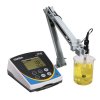aisach
Active Member
Anyone look into making a ph meter out of an arduino?
Ive seen people make fully automated systems with them for relatively cheap.
check out this one: http://arduinogrc.blogspot.com/2011/09/here-is-my-arduino-based-grow-room.html
Ive seen alot prettier versions of them but these are all i can find right now. The one i saw once had controlls to automatically adjust ph with ph buffers, ran fans and a/c at certain temps, and added nutes at certain ppm.
I've seen automated instruments used in the field. They still require the grower to add the buffers and push the cal sequencing button. The function would still be the same, yes? The instrument reads each buffer and does an internal adjustment on each, then provide a slope. This is the same principle as when a screwdriver is used to manually adjust the set-point.
Or are you saying that it then adds chemical to the hydro system that also adjusts the pH in the reservoir?
Might be a cost effective option for a large grow operation.















